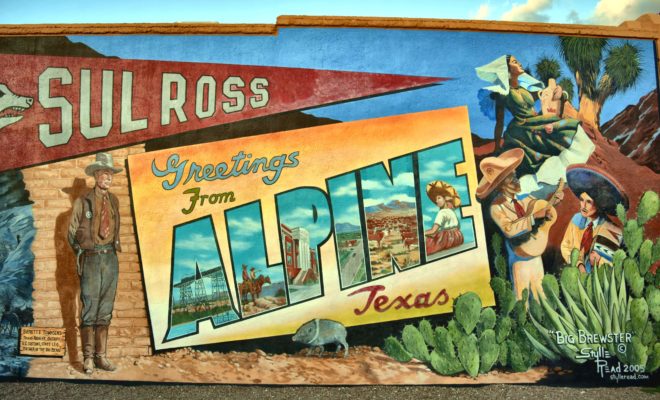Perched in the West Texas hills at 4,475 feet in elevation, Alpine beckons the Texas road tripper to explore and enjoy. This bustling but relaxed high desert town reveals its secrets like a ribbon of mountain road, with new discoveries around every corner. For a town of 5,000, Alpine offers a creative variety of attractions. My wife and I visited in late summer, before heading into Big Bend National Park, only a two-hour drive away. This two-part article will introduce you to some of these attractions—so come along for the ride!
If you’re new to the Trans-Pecos region, start your trip by arranging a tour of the Museum of The Big Bend on the grounds of Sul Ross University. The museum, one of several in the state, including Fair Park in Dallas, was built with money earmarked to celebrate Texas’ centennial in 1936.
Photo: John Spaulding. A Texas Pterosaur glides above the Museum of the Big Bend exhibits.
Upon entering the building, prepare to be startled by a replica of a Texas Pterosaur, soaring over the exhibits with its 22-foot wingspan. The original fossil was unearthed in the Big Bend region by University of Texas students in 1972, and it’s displayed at the Texas State Museum in Austin. The largest known animal to have ever flown on earth, the Texas Pterosaur is one of Big Bend’s Texas brags.
Photo: John Spaulding. Native American paintings and a Spanish carreta illustrate a portion of the Big Bend region’s colorful past.
The tour moves to subsequent native American peoples of the area and features a replica of a painted monolith, discovered at a nearby archeological site, named Tall Rock Shelter. Then come the Spanish conquistadors and the first known European explorer of the Big Bend region, Cabeza De Vaca in the 1530s, followed by growing Spanish settlements in the area.
The museum also highlights the history of the Buffalo Soldiers, fort outposts, a surprising twist to the story of Pancho Villa, hazardous mercury (cinnabar) mining during World War I and II, and the authentic interior of a general store circa 1920, donated by the family of an area shopkeeper.
Their collection “Five Centuries of Mexican Maps” recently debuted and is on display until December 15, 2019, featuring rare cartography over the centuries. Matt Walter, Curator of Collections, says of the museum, “This is where you get the picture of the Big Bend, and then decide where to explore from there. ‘We tell the story’ is our motto.”
Photo: John Spaulding.
The Ritchey Wine Saloon and Beer Garden offers food and drink only a short walk across the railroad tracks that bisect the town. In fact, the railroad established the need for Alpine and other whistlestop settlements, beginning in the 1880s. A dependable water supply in places like Alpine enabled the steam engines to refill and continue their journey. And The Ritchey structure is one of the last remaining railroad hotels still operating in the Trans-Pecos region. During its heyday, The Ritchey catered to the working class who made their livelihoods through railroad-related activities. While it does not offer hotel rooms for the evening, it features an old-fashioned bar and upstairs parlor and regularly plays host to musicians in the courtyard.
Photo: John Spaulding. The busy courtyard of The Ritchey, where performances are featured several times a week.
Owner Mattie Matthaei completed the building’s renovation and opened in March 2018. When asked what she enjoys about The Ritchey, she says, “There is some kind of gentleness and joyfulness in this building. My customers walk in and soften—they smile and are happy to be here.” She is also proud to carry the most extensive beer and wine collection in the Trans Pecos, without any of the snobbery.
When the urge for breakfast or lunch arrives, another short walk back into town reveals a bakery named Taste and See. Owner and mother of five Ginger Hillery specializes in freshly made breads and pastries made from 100 percent whole grains. Using a pink granite Balfour stone mill, she grinds the specially chosen grains on premises. Three local growers supply 85 percent of the organic produce she uses for her other culinary creations. Many of her mother’s professional paintings adorn the walls of the two-year-old bakery, which add an additional touch of home to her cozy establishment.
Photo: John Spaulding. Listen to the soothing sounds of trains passing through town at twilight.
Ginger encourages people to come to Alpine and be surprised by what they find. She says “Alpine is full of businesses run by small families, particularly women entrepreneurs. I think that because it is so remote, there’s room for people to follow their passion.” In Part Two of this adventure, we will explore more of that passion that makes Alpine worth the drive to this part of Texas.








